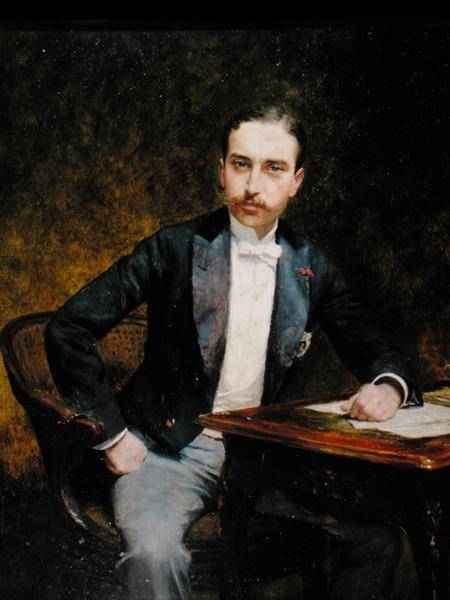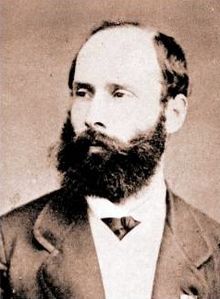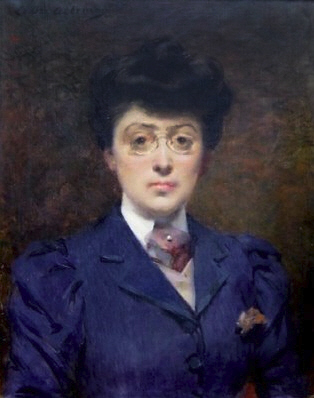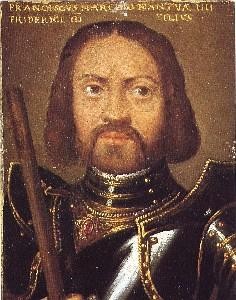_par_Jules_Bastien-Lepage_(1848-1884)_-_1879.jpg) |
| Sarah Bernhardt |
Sarah Bernhardt (1844-1923).
French courtesan & royal mistress.
Daughter of: Julie Bernard (?-1876), Dutch Jewish courtesan
Wife of:
1. Aristides Jacques Damala (1857-1889), Greek-born actor, mar 1882.
 |
| Charles Haas |
Her lovers were:
1) Charles Haas (1833-1902)
Lover in 1866
French actor
 |
| Charles Haas One of the models for Charles Swann 'The Circle of Rue Royale' by James Tissot @ Musee d'Orsay |
"As we have seen, Sarah---forgetting her earl disdain for her mother's career---had no problem with sharing her favors. It was during these first years at the Odeon that she took up with one of the most distinguished men of her time, the ultra fashionable Charles Haas, who was not only elegant, handsome, and sophisticated but was socially impeccable: one of the very few Jewish members of the Jockey Club and accepted by the aristocracy of the Faubourg St. Germain---le gratin. Among his close friends: Degas and the Prince of Wales. In the 1860s he was famous for his worldliness and his success with women; today he is remembered only as Sarah's lover and as the direct model for Proust's Charles Swann. (Sarah, of course, was to be the model for Proust's Berma.). . . The letters that Sarah wrote to Haas at this time make it clear that he is the adored one, she the adorer. . . And they stayed friends until he died, in 1902. Indeed, staying on the best of terms with her ex-lovers was one of Sarah's extracurricular talents." (Sarah: The Life of Sarah Bernhardt)
 |
| Emile, Comte de Keraty |
2) Emile de Keraty, Comte de Keraty (1832-1904)
French politician, soldier and author.
"Marie Colombier tells a different story. Maman and Aunt Rosine take Sarah to the theater with instructions to attract the right kind of man. It works! A handsome and which young aristocrat follows her home. Soon they're a couple. Emile de Keraty, 'as a jaded man about town, was intrigued by Sarah's bizarre mixture of naivete and corruption. As for Sarah, though she was very attracted, she certainly didn't love him, and after his passionate embraces, she liked him even less...." (Gottlieb, 2004, n.p.) [Bio2:SFHP]
"It was during this period that Sarah collected her first real lover, a handsome thirty-ish hussar about-town named Emile, le comte de Keratry. As usual, there are conflicting accounts of how they met. Sarah barely mentions him in her memoirs...." (Gottlieb, 2004)
3) Edmond Rostand (1868-1918)
French poet & playwright.
4) Edouard Angelo.
4) Edouard Angelo.
" . . .Aside from Jarrett, her traveling companions included her old friend and now rival Marie Colombier, filling in for Bernhardt's sister Jeanne, hospitalized for morphine addiction; and Edoaurd Angelo, Bernhardt's leading man and sometime lover. . . ." (Sarah Bernhardt's First American Theatrical Tour, 1880-1881: 13)
" . . . Edouard Angelo accompanied Bernhardt on the 1880 and 1886 American tours as well." (Theatre Research in Canada)
"Edoaurd Angelo was Sarah's lover and leading man on her American tour. . . ." (My Double Life: The Memoirs of Sarah Bernhardt: 329)
 |
| Gustave Dore by Nadal, 1867 |
9) Gustave Dore (1832-1883)
French artist, print-maker, illustrator & sculptor
Character or Persona: "...At 5 Rue Bayard, just around the corner from the Moulin, was the studio of the artist Gustave Dore -- best known in England perhaps for his illustrations of Paradise Lost and Don Q
10) Gustave Moreau.
11) Gustave Schlumberger.
10) Gustave Moreau.
11) Gustave Schlumberger.
12) Henri-Maximilien-Joseph, Prince de Ligne. (1824-1871)
Prince de Ligne & d'Amblise
Son of: Eugene-Francois-Charles-Lamoral de Ligne, 8th Prince de Ligne &
Amelie-Melanie de Conflans.
Husband of: Marguerite de Talleyrand-Perigord
Natural offspring:
 |
| Maurice Bernhardt @Houghton Library Harvard |
Maurice Bernhardt 1864-1928)
French playwright & theatre director.
"Her personal life was equally dramatic as her stage personas, and saw her become a mistress to Henri, Prince de Ligne (Belgium) with whom she had her only child Maurice in 1864. Due to Henri's status, they never married; although Sarah did go on to marry Aristides Damala, a Greek born actor in 1882. Their marriage deteriorated quickly due to Damala's addiction to morphine and Sarah never married again." (The Culture Trip)
13) Jean Richepin.
14) Jean Sully Mounet.
15) John Castle.
16) Jules Lemaitre.
14) Jean Sully Mounet.
15) John Castle.
16) Jules Lemaitre.
 |
| Louise Abema |
17) Louise Abbema (1853-1927)
French painter, sculptor & designer.
18) Lou Tellegen (1881-1934)
Dutch actor, director & screenwriter.
Lover in 1910-1911.
Husband of:
1. Jeanne de Brouckère, mar 1903; div. 1905
2. Geraldine Farrar, mar 1916; div. 1923
3. Nina Romano, mar 1923; div. 1928
4. Eve Casanova, mar 1930; div. 1932
" . . . The mystery of Reece's private life makes it difficult to know what number wife Jeanne was, but this was her second marriage, having been abandoned by her first husband, Isadore van Dommelen, a dashing Dutchman who, taking the name Lou Tellegan, became a well-known state and screen actor and lover of the actress Sarah Bernhardt. His embellished autobiography, Women Have Been Kind, is a rollicking read. In 1934 Tellegan would kill himself, spectacularly, in his Hollywood apartment by committing hara-kiri on a pair of golden scissors, toppling to a floor spread with his press cuttings of many years. But at this time Diane van Dommelen was in her early twenties and living quietly with her mother and stepfather. A decade later she would become someone with whom several people would have to deal very carefully." (Escape to Provence: 69)
19) Napoleon III of the French.
 |
| Lou Tellegen |
Dutch actor, director & screenwriter.
Lover in 1910-1911.
Husband of:
1. Jeanne de Brouckère, mar 1903; div. 1905
2. Geraldine Farrar, mar 1916; div. 1923
3. Nina Romano, mar 1923; div. 1928
4. Eve Casanova, mar 1930; div. 1932
" . . . The mystery of Reece's private life makes it difficult to know what number wife Jeanne was, but this was her second marriage, having been abandoned by her first husband, Isadore van Dommelen, a dashing Dutchman who, taking the name Lou Tellegan, became a well-known state and screen actor and lover of the actress Sarah Bernhardt. His embellished autobiography, Women Have Been Kind, is a rollicking read. In 1934 Tellegan would kill himself, spectacularly, in his Hollywood apartment by committing hara-kiri on a pair of golden scissors, toppling to a floor spread with his press cuttings of many years. But at this time Diane van Dommelen was in her early twenties and living quietly with her mother and stepfather. A decade later she would become someone with whom several people would have to deal very carefully." (Escape to Provence: 69)
19) Napoleon III of the French.
 |
| Jerome Napoleon |
20) Prince Napoleon Bonaparte (1822-1891)
French Prince
Comte de Meudon; Conte di Moncalieri; 3rd Prince de Montfort
Son of: Jerome Bonaparte, King of Westphalia & Catherine von Wurttemberg.
Husband of: Clotilde di Savoia
daughter of Vittorio Emmanuele II of Italy.
"Prince Napoleon, commonly known as 'Plon-Plon,' often used to come to George Sand's rehearsals. He was extremely fond of her. The first time I ever saw him I turned pale, and felt as though my heart had stopped beating. He looked so much like Napoleon I. that I disliked him for it. By resembling him it seemed to me that he made him seem less far away, and brought him nearer to every one." (My Double Life: The Memoirs of Sarah Bernhardt: n.p.)
21) Oscar Wilde (1854-1900)
22) Paul Mounet.
23) Pierre Berton.
24) Pierre Loti.
23) Pierre Berton.
24) Pierre Loti.
 |
| Robert de Montesquiou |
French poet, novelist, art critic, chronicler, memoirist, designer, book collector & patron of the arts.
 |
| Samuel Jean de Pozzi |
French surgeon & gynecologist, soldier & politician, artist & collector
[Sarah & the Doctor]
[Sarah & the Doctor]
.jpg/220px-Samuel_Pozzi_(photo._Pierre_Petit).jpg) |
| Samuel Pozzi |
and Marthe-Marie Ines Escot-Mesion
Husband of: Therese Loth-Cazalis, Heiress of a railroad magnate, mar 1879
Lover of:
1. Georgette Leblanc, French opera singer
2. Rejane, French actress
3. Emma Sedelmeyer Fischof (in 1890)
4. Sarah's lover in 1879
"In 1864, Pozzi began to his study medicine in Paris. He also met Sarah Bernhardt through a childhood friend, the actor Jean Mounet-Sully, and, according to historian and childhood friend Gustave Schlumberger, they briefly became lovers yet remained lifelong friends afterwards." (Wikipedia)
 |
| Victor Hugo by Achille Deveria, 1829 |
27) Victor Hugo (1802-1885)
French poet, novelist & dramatist.
Love Life: "...Among her friends were the authors George Sand (1804–1876) and Victor Hugo, artist Gustave Moreau (1826–1898), novelist Pierre Loti (1850–1923), and playwrights such as Jean Richepin (1849–1926) and Jules Lemaître (1853–1914), who also became her lovers." (Shapira, 2009).
Personal and Family Background: Sarah was the illegitimate daughter of a Jewish courtesan. "Sara Marie Henriette Rosine Bernard was born ca. 22 Oct 1844 to the Dutch Jewish courtesan Youle (Julie) Bernhardt and an unknown father. Her mother, having no use for a young child, sent her to live in a pension, then a convent, and at age 13 to the Conservatoire National Superieur de Musique where she studied acting." (Codex99).
"Julie Bernardt was the daughter of a Jewish spectacle merchant...." (Scandalous Women)
Physical Traits & Personal Qualities: "...Sarah Bernhardt had frizzy red hair, a white face and an unfashionably, waiflike figure. She possessed a very modern genius for publicity...." (Ridely, 2012, n. p.) [Ref1] [Ref2] [Bio1:Tweedland Gentleman's Club]


.jpg/330px-Prince_Edward_(1920_portrait).jpg)















